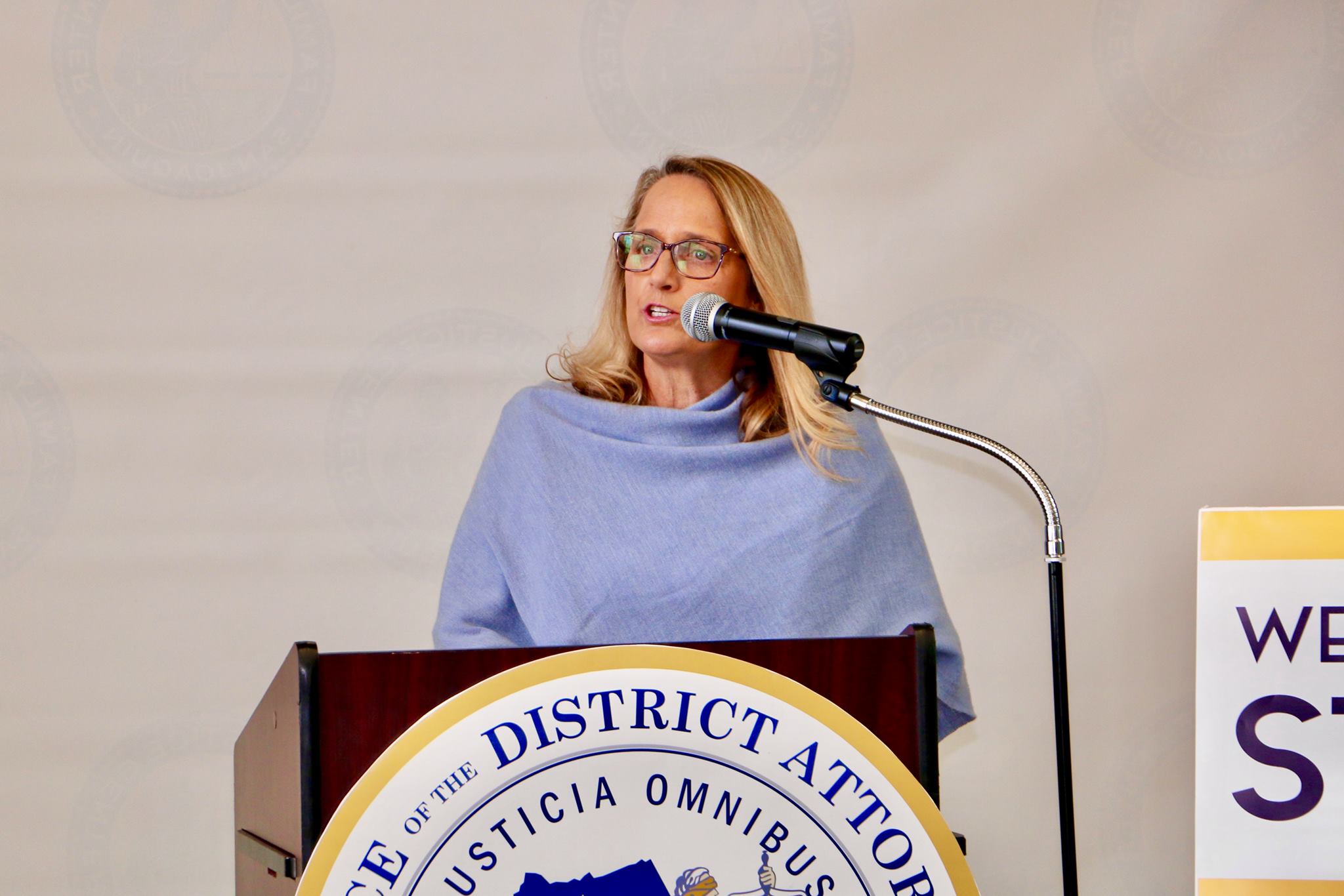California Prosecutor Quits D.A. Association: “Let’s Accept Responsibility for The Mistakes We’ve Made”
The CDAA has opposed “almost all change that the voters of California had asked us to enact," San Joaquin County DA Tori Salazar said in a Q&A.
Daniel Nichanian | January 23, 2020


This article originally appeared on The Appeal, which hosted The Political Report project.
In a Q&A, San Joaquin County DA Tori Salazar says she left the CDAA over its “opposition to almost all change that the voters of California had asked us to enact.”
San Joaquin County District Attorney Tori Salazar has left the California District Attorneys Association (CDAA), a group that lobbies in the name of state DAs and that also trains prosecutors. She cited its resistance to criminal justice reform in a letter she wrote last week.
Salazar, a Republican, is the first DA to leave a statewide association on these grounds since Philadelphia’s Democratic DA Larry Krasner quit Pennsylvania’s in 2018. In California and Pennsylvania, and elsewhere in the country, these groups have been powerful opponents of reforms that aim to reduce incarceration and lessen charging or sentencing levels; they frequently champion making laws more punitive.
I talked to Salazar this week, in a Q&A interview transcribed below, about why she left the CDAA and why conventional approaches to prosecution are not working, and about a few of the policies the CDAA has fought.
“We looked at what the CDAA was doing, and we just felt that they were in opposition to almost all change that the voters of California had asked us to enact,” Salazar said.
The CDAA opposed numerous ballot initiatives including Prop 36 (2012), which weakened the state’s three-strikes system, Prop 47 (2014), which defelonized drug possession and some theft charges, Prop 57 (2016), which expanded parole and restricted prosecutors’ broad discretion to treat minors as adults, and Prop 64 (2016), which legalized marijuana. Voters approved all four initiatives overwhelmingly, by margins ranging from 15 to 39 percentage points. Over the past two years, it has fought landmark laws that restricted the prosecution of minors as adults or created new alternatives to incarceration for parents, among others.
Salazar denounced the CDAA leadership’s refusal to draw lessons from voters’ repeated embrace of criminal justice reform at the ballot box. “Instead of looking at it as an opportunity, they looked at it as opposition,” she said.
The CDAA’s board of directors, which sets the association’s stance, features just a fraction of the state’s prosecutors. But as long as the CDAA represents all 58 counties, Salazar said, the “inference” is that “it is across the state of California that district attorneys are opposed” to reform.
By contrast, her departure could puncture the premise, often reflected in media coverage, that a state association reflects the unified voice of law enforcement, and it could bring into sharper relief the growing political contrasts between prosecutors. Other DAs “are going to probably come out” as well, she said.
Salazar described recent popular initiatives as a wake-up call for her own thinking. “It forced us to look at ourselves, accept responsibility,” she said, explaining that it compelled her to reckon with voters’ dissatisfaction with punitive policies, reassess assumptions she was trained in, and shed “old theories that didn’t hold true” about what boosts safety. Conventional practices have spread “generational harm,” she said. Asked about the state’s recent restrictions on three-strikes sentences and felony murder prosecutions, Salazar offered similar responses. She did not embrace reform on either issue, though she acknowledged that the thinking that led California to adopt these schemes is in question.
Voters “had the courage to push us and now we have to have the courage to deliver,” she said. “They’re asking to have the courage to think outside the box to find better pathways for people to be successful, and to heal your community. So why not lean into that and figure out what works and what doesn’t work?”
This interview has been condensed and lightly edited for clarity.
Why did you choose to leave the CDAA? In a letter, you stated that “the association is out of touch and unwilling to find new approaches to criminal justice.” What did you mean by that, and why did that lead you to leave the group?
We looked at what the CDAA was doing, and we just felt that they were in opposition to almost all change that the voters of California had asked us to enact. [Voters] spoke and said, “We want to see some changes. We don’t believe the system is as effective and as efficient as it could be.” At first, I have to say, you’re like, “Wait, what? What’s going on here?” And then you stop to think about it, and you think, “Okay, let’s listen, let’s work, let’s think about what we’re doing, and can we be doing it better and more efficiently?”
In large part because of the high volume work everybody’s doing, we weren’t stepping back and saying, “Are we increasing public safety? Are we doing work to prevent harm in our community? Are we creating a healthy community?” So we listened to what the voters had to say. We implemented the changes that they wanted and that they demanded of us by putting it to a vote. I felt that there was an opportunity for us to engage with our communities to hear their voice about wanting criminal justice reform.
Throughout, I didn’t see the CDAA really engaging in that change. Instead of looking at it as an opportunity, they looked at it as opposition. And I think it was more valuable to look at it as an opportunity. When I stepped back from it, there really wasn’t a service being provided that was representative of what we were doing here in San Joaquin County. And at that point, I decided to no longer be a member.
From what you’re saying, it sounds like the success of some of these initiatives, and perhaps the organizing around them, changed your own thinking. Is that right? Have you rethought your views and role in response to the success of these popular initiatives?
Yes, I think most DAs have had an evolution. We were all trained and brought up in one way, and that this way worked. But in reality, when we went back and we looked at it, we saw a number of problems.
Laws were implemented in a racially discriminatory manner. I’m sure that wasn’t anybody’s intent, but that’s how they worked out. You have to take ownership and responsibility for that.
We saw that we were not communicating well with our communities and building trust and transparency, and that’s why we had a lot of victims and witnesses who didn’t want to cooperate with us.
We saw a lot of people suffering generational harm, driving them into poverty. Just coming into the criminal justice system is very expensive. And so what were we really driving? Were we really deterring the crime from occurring, or were we driving more people into poverty where we create generational harm, where people could not get jobs because of that past felony conviction? They’re going to get paid under the table. They’re not gonna pay into Social Security or retirement. You’re just creating the cycle of generational poverty. And then, how do you balance that with holding people accountable for the actions they’ve taken?
So we stepped back and heard what the people were saying, and we said, “Okay, we understand that you’re not happy with the way things are going. We understand that you want to see change. And thank you, because we didn’t look at it that way. And now we do look at it differently.” Even though these changes were first a little bit shocking, we just weren’t used to change. They’ve actually been a tremendous opportunity. It forced us to look at ourselves — accept responsibility.
They had the courage to push us and now we have to have the courage to deliver.
And I think the CDAA wasn’t delivering. They were hoping that things would revert back to the way it was. I think that that didn’t serve them well. It left them behind on the reforms. It didn’t increase public safety. It created a lot of frustration, and missed messaging and opportunities to really engage our communities. They’re asking to have the courage to think outside the box to find better pathways for people to be successful, and to heal your community. So why not lean into that and figure out what works and what doesn’t work?
Some DAs now do push for more reform-oriented policies, and yet the CDAA has had a pretty consistent record of opposing reforms. Can you spell out how you see the CDAA operating in a way that produces that consistent position, as opposed to making it possible for people who have different views to influence what the CDAA position is?
The CDAA represents all 58 counties, and so when they take a position the inference is that this is the voice of all 58 counties and that it is across the state of California that district attorneys are opposed to it. Now, each district attorney can stay opposed, neutral, or endorse whatever bill that they’re putting forward. But CDAA as an organization is one voice for the entire state.
But what we found is that not every voice was being heard. The voice was the old voice. There weren’t opportunities to learn and gain from working with these changes to the law. We saw a CDAA not listening to the people. In most cases, instead of seeing an opportunity, they went with the opposition. I think taking that stance has further alienated the people we serve, and has made it seem that the conversation is only about “light on crime” or “tough on crime.” And that’s not what reform is. Reform is victim-centric. It’s still ensuring public safety and the well-being of everybody in our community. The core of reform is public safety. What it does is it says, “Let’s be smart about this. Let’s look at the totality.”
I’ll give you an example. We have a domestic violence program for misdemeanors, a 52-week program. I fought for this because we believed that the 52-week program was better than the 16-week program. But the program runs almost $2,000. Most of my community can’t afford it, to even go there. What happens is they get referred, they go until they can, and then they can’t go anymore because they can’t afford to go, and then they get a violation and they come back in. So we’re just turning the system over and over and over, and in the meantime, 80 percent of them are back home with their family and they’re not getting any better. It was a program that we believed in because we thought more was better, but the reality is it really wasn’t working.
We need to have this conversation without being labeled one thing or another. These are complex, difficult, time-consuming, expensive, emotional, traumatic, life-and-death decisions. And we need to be able to have that conversation with our community. Let’s look at what we’re doing. Let’s accept responsibility for the mistakes we’ve made. Let’s own up to it. And let’s build a criminal justice system that we’re proud of, not one that is based on old theories that didn’t hold true. What we do is say, “If your issues are driven by mental health or substance abuse disorder, which affect every family in America, then we need to get you into the services to get you well.” If you’re a driver of violence or harm, harming children or shootings or homicides, then we’re going to come and we are going to bring everything we have. Because we have the resources now, because we’re not spread so thin with cases that really aren’t criminal justice-driven and more societal.
What do you think should be next as an alternative to the CDAA? Are you aware of other DAs who are considering following you, and whether or not that happens, is there another form of partnership with other DAs that you believe would better support voters’ initiatives?
I think more DAs are going to think about their decisions more closely and differentiate between their decision of what’s best for their county and what the CDAA is recommending. I hope more voices will be raised.
Some people are going to say, “Let’s create change from within.” Some are going to probably come out and create the change from outside. I respect whichever way people want to go.
Are you afraid of losing something by leaving the CDAA, whether in terms of partnerships, training, access to databases?
No. I don’t see that as a concern. The information they have is pretty much public record, and I don’t think they wouldn’t be willing to share it. I don’t see that as a loss for me.
I’d like to delve into specific reforms that the CDAA opposed. Prop 36 restricted California’s expansive “three-strike” policy in 2012; in 2014, Prop 47 lowered sentencing for drug possession and some theft charges. The CDAA fought both initiatives. What do you think their impact has been? And what other sentencing reforms would you support to build on them?
Prop 47 and 64, the parts that have allowed us to clean up people’s past criminal histories, are driving more people to traditional employment. That’s going to help our economy. You can break that generational poverty and start stabilizing some of the homes.
We would like to see the opportunity to seal records because expungement doesn’t really provide the pathway to success that people think it does. And I know that there’s new legislation now in the beginning of the year that will help steal some of those records. But those who committed low-to-moderate offenses, when you’ve completed your sentence, it should just be an automatic seal on those cases. It’s acknowledging and recognizing you for doing the right thing: Everybody can fall down, and if you pick yourself up and you’ve done everything right, why do I call you a felon for the rest of your life, same as the person who’s killed 30 women?
The other side of 47 is that all thefts under $950 are misdemeanors. Now that part needs to be modified. We made a mistake in the past where maybe we were overcharging petty theft, when people were really hungry and they were homeless and they needed help. They didn’t need the criminal justice system, and incarcerating them for two or three days wasn’t going to change the fact that they’re homeless. It’s probably going to exacerbate that. But what we saw instead was people coming in who are very organized. [Prop 47] doesn’t give us a lot of tools to address these individuals, other than continually doing misdemeanor after misdemeanor after misdemeanor. We shouldn’t have been charging people who are hungry and poor and homeless. But we also have to have a tool to take on sophisticated, organized crime.
In the spirit of Prop 36, would you favor further rolling back the three-strikes system?
I haven’t looked at 36 in a while. I can understand why people came to three strikes because they were frustrated with the criminal justice system and they wanted to find a different way. What we need is really get to what the intent was. I understand why they are afraid, and I respect that, but we didn’t sit down and have a really good conversation about, “Okay, when we have this kind of extreme violence, how do we address it? What do we do, and how do we make it work? And if we’re going to take on measures like this, are we doing data collection to prove that it does, and is it driving the results that we expected?” There was a time where we used three strikes quite a bit; we don’t use it very much now because it wasn’t driving the results that we thought it would drive.
Perhaps the biggest recent fight between the CDAA and lawmakers has been over Senate Bill 1437, which restricted felony murder statutes. Many California DAs have fought this and sued over the law. The law provides for the resentencing of people who have been convicted under the felony murder rules. Do you support that bill, and the resentencing it sets up?
People were frustrated and wanted to hold everybody accountable and responsible, and I understand why people felt that way. We all feel that way when you feel you’re not safe in your community. You want something and you want it to be strong. That’s what we all grew up in: They do harm, we do harm. — that kind of mentality. In reality, we need to slow down and say, “What is it that we want?” We want a safer community, and we implemented the felony murder rule, but what did it do? Did it serve the purpose that we want? Did it achieve the results that we wanted? And did we implement it fair across the board? Did we use it in a manner that ensured public safety? That’s where we got to go back and look at felony murder, and look at if it achieved what we wanted to achieve. If it did, then OK, but if it didn’t, how do we make it better? That’s really what they said in [SB] 1437, is go back and look at those cases, and figure out, did we do it right or did we not? And if you didn’t, you need to correct it.
We need to start having this conversation with the community because there are people that are going to come back out, and we have to explain why they’re coming back, but also while we have them there, we need to be working within the prison system to make sure that we’re getting every rehabilitative tool possible.


